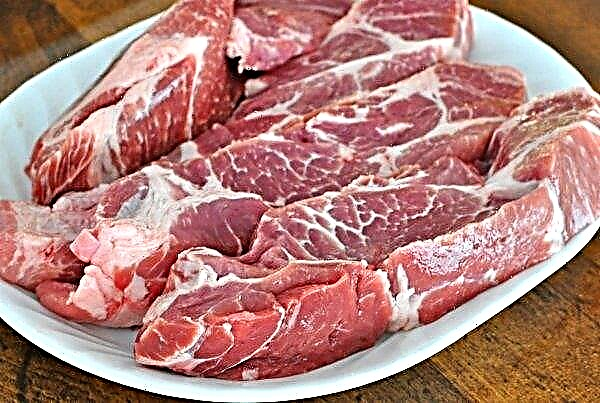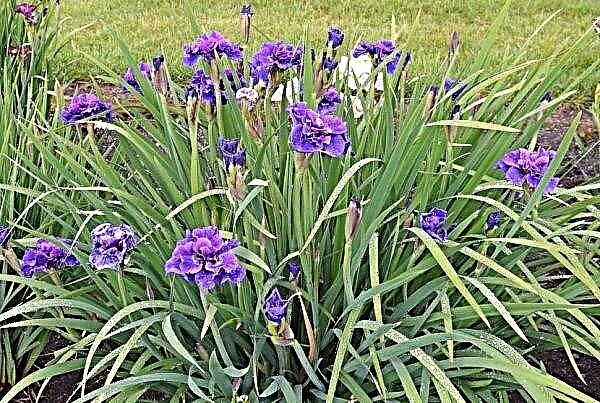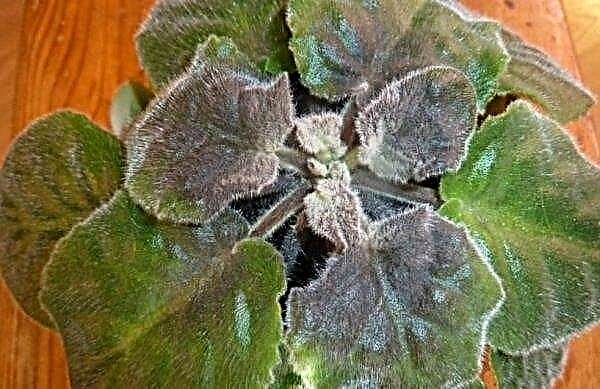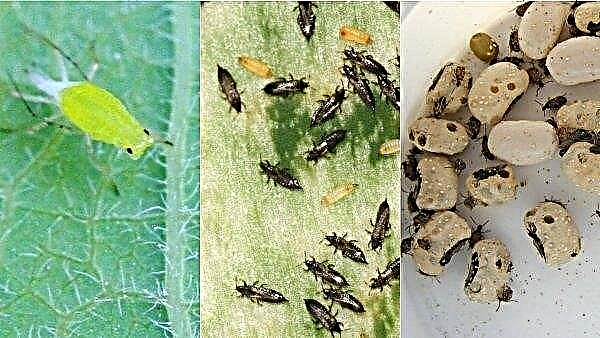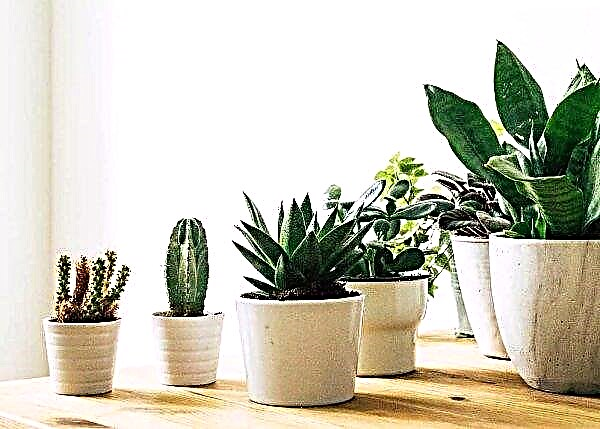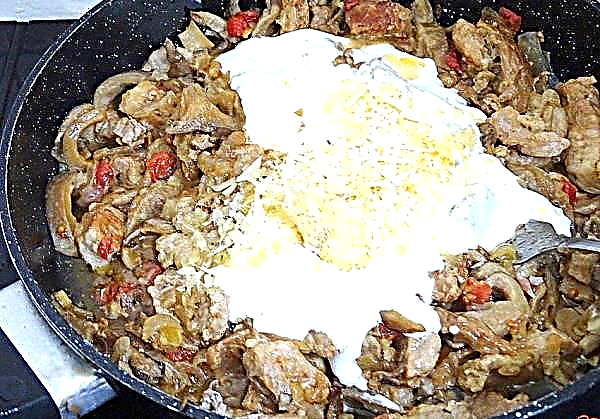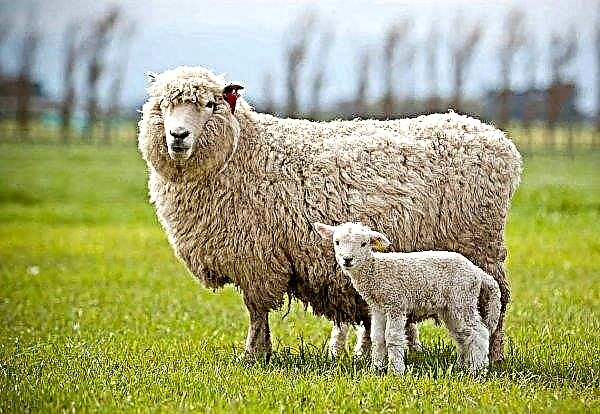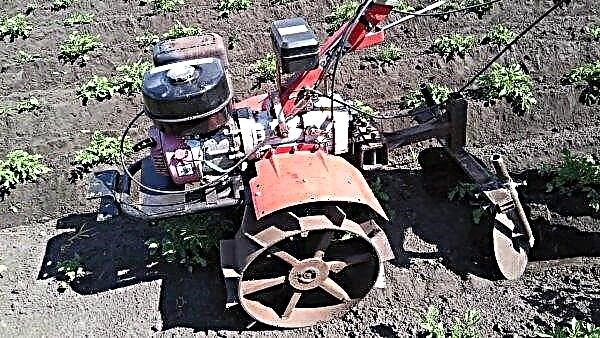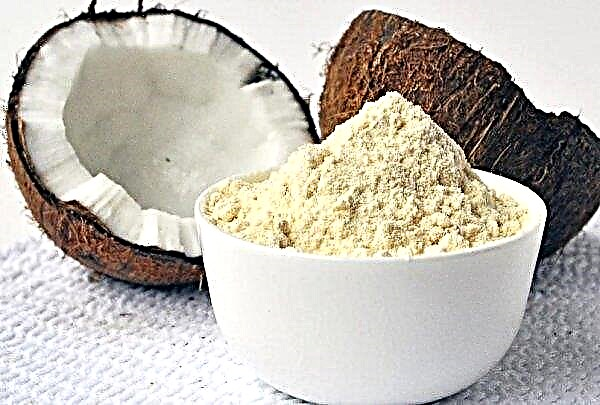Modern gardeners have long grown a hybrid of cucumber Masha F1, which is produced by the Dutch company Seminis. Everyone who at least once raised this hybrid had the opportunity to appreciate the remarkable yield, excellent fruit taste and ease of cultivation.
In this article we will consider the characteristics of the cucumber Masha F1, we will tell you how to grow this hybrid from seeds (direct sowing into the soil and through seedlings) and how to care for it.
Grade description
| Selection country | Dutch company Seminis |
| Plant type | Determinant |
| Type of pollination | Parthenocarpic (self-pollinated) |
| Ripening time | Early ripening (the beginning of fruiting from the 36th day) |
| Bush characteristic | Weakly branched, with an ovary of 5-6 cucumbers in each internode |
| Productivity | In a greenhouse up to 11 kg per 1 square meter |
| Fetal weight | Up to 100 g |
| Green length | Up to 11 cm |
| Fetal shape | Cylindrical, coarse peel of the fetus |
| Application | Fresh use, canning, salting |

Advantages and disadvantages
- pros
- determinism (a hybrid has an unlimited growth point);
- moderate branching;
- resistance to diseases and pests;
- early ripening;
- long fruiting period;
- parthenocarpy (self-pollination);
- yield potential;
- great taste of fruits, without characteristic bitterness;
- fruits of the gherkin type (medium-sized);
- bunch fruiting;
- suitability for conservation (preservation of density).
- Minuses
- tendency to overgrow fruit;
- rough skin;
- virtually absent cucumber flavor;
- variable productivity in the open ground (hybrid productivity is very dependent on the vagaries of the weather).

Sowing seeds for seedlings
The seedling method of growing hybrids has its advantages:
- allows you to get the crop early;
- makes it possible to get a crop in the northern regions;
- increases the fruiting season.
Optimal timing
Experts recommend sowing hybrid planting material to obtain viable and strong seedlings 30–35 days before the expected date of planting at a permanent place of cultivation.
For example, if the estimated date of planting is May 15, then you need to sow cucumbers no earlier than April 10-15. It is not recommended to sow with a long run in time, the plant reacts poorly to the roots disturbed during the transplant, begins to hurt and stops growing for a long time. A poorly transplanted seedling gives the first crop later or simultaneously with cucumbers that were sown directly into the ground, which discredits the very idea of getting an early crop.
A poorly transplanted seedling gives the first crop later or simultaneously with cucumbers that were sown directly into the ground, which discredits the very idea of getting an early crop.
Important! When storing seeds in a room where the temperature does not rise above + 15 ° C, and humidity is kept within 50% –60%, the seed of cucumbers can be stored for 8–10 years, and they will not lose their germination.
Soil mix
Ready-made soil mixtures for growing cucumber seedlings can be purchased at garden centers.
You can also prepare soil for seedlings with your own hands. To do this, you need to take:
- 10 kg of chopped peat;
- 5 kg of river white sand;
- a liter jar of wood ash (sifted).

Mix all the ingredients thoroughly, and then bake in the oven, sprinkling on a baking sheet with a layer of 5 cm, at a temperature of 220 degrees for 10-15 minutes. Annealing will disinfect the soil and save it from the presence of pathogenic flora. The soil is ready for sowing seeds.
Gardeners should not forget that no nutrients are present in such soil, therefore, after the appearance of sprouts, young plants will need root and foliar top dressing.
Did you know? Cucumbers contain vitamin B1, vitamin B2, vitamin B3, vitamin B5, vitamin B6, folic acid, vitamin C, calcium, iron, magnesium, phosphorus, potassium and zinc.
Capacity for growing
Cucumber seedlings can be grown:
- in peat tablets with a large diameter;
- in peat cups;
- in pallets;
- in any suitable plastic or paper containers with a volume of at least 0.5 liters and with holes in the bottom for water drainage.

Many gardeners adapt all kinds of containers at hand (yogurt cups, cut plastic bottles, tetra milk packs, cardboard boxes of suitable diameter) to grow hybrid cucumber varieties.
In improvised landing tanks, holes in the bottom are also necessarily made. Holes are necessary so that when watering, excess water does not stagnate in the roots and can drain into the pan. This container for growing cucumbers is not very good, since it does not decompose (or decompose for a long time) in the ground, which means that it cannot be buried in the ground.
That is, when transplanting to a permanent place of cultivation, the root system of cucumbers can be injured, which means that the plants will hurt and grow stunted. Although it should be noted that for the cultivation of tomatoes that tolerate transplantation almost painlessly, such containers are the best suited.
Seed preparation
Quite often, the seeds of the Masha F1 hybrid, sold in specialized seed stores, are already protected from infections and ready for sowing, so they do not need to be treated with potassium permanganate or other solutions for disinfection. Such seeds are usually colored green, red or orange. If the purchased seeds are not previously processed (their color is white), they must be prepared for sowing:
If the purchased seeds are not previously processed (their color is white), they must be prepared for sowing:
- Soak - the seed is wrapped in a moistened napkin and kept at room temperature until sprouts appear. There should be very little moisture on the surface of the seeds, since excess water will prevent oxygen from entering the seeds. Soaking seeds can be done in ordinary water, as well as in growth stimulators purchased in the store (epin, emistim). As a liquid for germination, you can use melt water or natural growth stimulants (honey or aloe juice diluted with water).
- Hardening - wrapped in a damp cloth, the seed that has bent over is placed for a couple of days in a refrigerator (on the side wall). Hardened seeds are immediately planted in the ground, this procedure increases their resistance to low air temperatures.
Did you know? Cucumbers contain a sufficient amount of sugar, B vitamins and electrolytes to replenish the necessary nutrients lost by the body in the fight against stress.
- Disinfection - the outer shell of the seeds can carry pathogenic flora, which, gradually developing, over time will lead to the occurrence of diseases already in adult plants. To avoid this, the seeds are treated in a pale pink solution of potassium permanganate. To disinfect, it is enough to withstand the seeds in the solution for 10-15 minutes, after which they must be washed with clean water.
Video: seedbed preparation of cucumber seeds
Preparing seeds for planting is a necessary and important procedure: it reduces the time before the first sprouts appear, positively affects the plant's resistance to stress and contributes to a higher yield of the hybrid.
Important! If the gardener wants to speed up the sowing of long-stored seeds of cucumber (6–8 years), they should be aerated for 18 hours. The aquarium compressor is lowered into a liter jar of water, where the seeds are wrapped in gauze. After such aeration, the seed is immediately planted in the ground.
Sowing seeds
Depending on the seeding method, some steps vary significantly. Consider the two most popular ones.
Sowing in peat tablets
They can be purchased at any specialized seed store. Peat tablets come in different diameters; for growing cucumber seedlings, it is recommended to take the largest, small diameter tablets are used for growing flower and strawberry seedlings. Seedling tablets look like flat dry disks with a height of not more than 3.5 mm. The advantages of growing in peat tablets are that the root system of the cucumber does not suffer during transplantation, as it is planted with a peat cup.
Seedling tablets look like flat dry disks with a height of not more than 3.5 mm. The advantages of growing in peat tablets are that the root system of the cucumber does not suffer during transplantation, as it is planted with a peat cup.
How to sow:
- Warm water is poured into a large low bowl with a wide bottom (in no case hot). For processing 10 peat tablets, 300–500 ml of liquid will be sufficient.
- Peat tablets are laid out at the bottom of the bowl, covered with water, and left to swell evenly for 15–30 minutes. During this time, the tablet absorbs water and the peat in it swells, the flat disks turn into cylindrical peat cups with a gauze shell, which prevents them from spilling. In well-absorbed peat cups, there are no dry or hard parts left.
- Peat tablets ready for sowing are removed from the bowl and set in a flat container with sides (pallet). This is necessary in order to make it convenient to water the seedlings under the root. Every two or three days, a little warm water is poured into the pan, which will gradually be absorbed into the glasses. In this pan, plants will be grown for the first 10 days of life.
- In the upper part of each peat cup, 2 seeds of the Masha F1 hybrid are laid out at a distance of one and a half centimeters from each other, and by pressing with a finger, they are deepened in moist peat (not deeper than 2 cm).
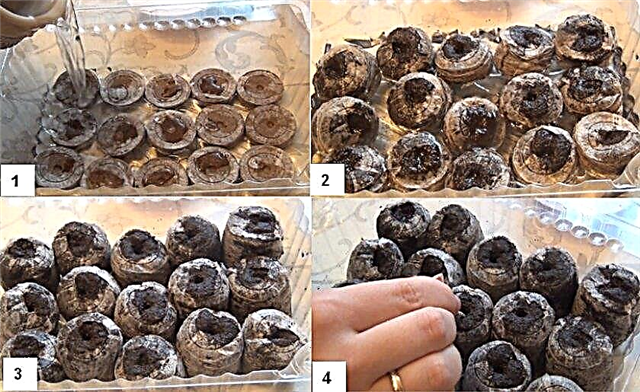
- At the end of sowing, the pan, with peat cups standing in it, is covered with a transparent cover or plastic film and set for germination in a dark and warm place. The film will create a greenhouse effect and prevent the water from evaporating too quickly.
- The greenhouse with germinating seeds must be constantly monitored, it is assumed that the sprouts will appear on the third or fourth day. It is impossible to suppose that the greenhouse with young sprouts remained closed for a long time, this will lead to elongation of seedlings.
- After the first sprouts appear, the pallet with peat cups is put on the window or on a special table for seedlings, which has a backlight. The transparent cover or polyethylene is removed. The seedlings standing on the window are aired twice a day, opening the window in the morning and evening.
- When the first true leaf appears on seedlings - peat cups in the pan are pushed so that a distance of 5 cm is formed between them. If the size of the pan does not allow this, you can put each peat cup in a separate pan, for example, cut from the bottom of a plastic bottle. With the advent of each new leaf, the seedlings are spreading wider and wider. This is due to the need for access of sunlight and oxygen to each plant.
- When the time comes to plant young plants in a permanent place, peat cups (already well braided by the roots of a cucumber) are simply placed in the planting pits and covered with soil. When landing, it is necessary to ensure that the surface of the cup coincides with the surface of the soil, that is, you do not need to deepen them too much.

Sow in peat mugs
Peat cups are also purchased in gardening shops; it looks like an ordinary pot for seedlings with a hole for draining water in the bottom. The popularity of this type of pots for seedlings is explained by the fact that the material from which they are made is made of ground and softened peat with the addition of humus.
Young plants grown in a peat cup are planted in the ground together with a tank, the walls of which gradually decompose in the ground and serve as fertilizer for the roots. In the process of transplanting into the open ground, the delicate root system of the cucumber does not suffer at all.
How to sow:
- 2 seeds are planted in each pot, after 10 days one of the plants is removed, leaving it stronger and stronger. The seed planting depth is not more than 1.5–2 cm. A deeper planting can delay the appearance of sprouts on the soil surface, and a too shallow planting will result in the seed coat remaining on the sprout preventing the spread of the first (fake) leaves. The distance between the two seeds is 3 cm. By removing the extra seedling, they should never be pulled out of the ground, but cut off at the point of contact with the ground. This is done so as not to damage the root system of a nearby cucumber.
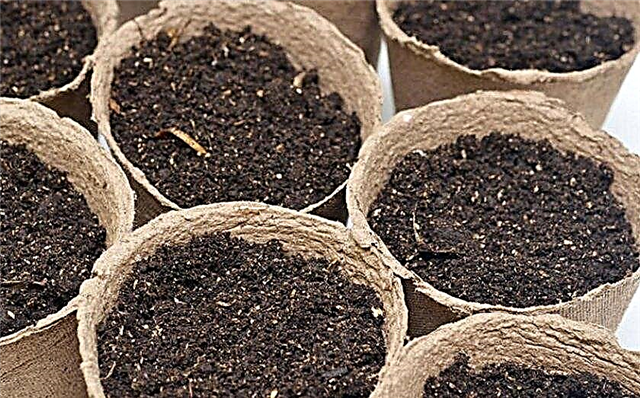
- The planted seeds are lightly watered with warm water, and each pot is wrapped in a transparent plastic bag, after which they are left in a warm and dark place for two to three days to peck the sprouts. An individual drip tray for water drainage (saucer) must be provided for each landing tank. After the first sprouts appear, caring for them will be identical to caring for cucumbers grown in peat tablets.
Important! The culture of cucumber, like pumpkin, unlike other garden crops, very poorly tolerates transplantation. Even transplantation by transshipment does not give an absolute guarantee that the cucumber root system will not be disturbed or damaged. Cucumber is a very capricious and tender plant that reacts sharply to changes in growing conditions: sharp changes or lowering of air temperature, humidity, damage to the root system.
Seedling Care
Cucumber is an annual subtropical plant and bears fruit best in a warm and humid environment, with good lighting and the availability of nutrients. This plant is very sensitive to adverse environmental conditions. Air temperature
Air temperature
Cucumbers love heat, therefore, for the proper development of seedlings, the correct temperature regime is very important. For germination, the most acceptable temperature is in the range +25 ... + 35 ° C. After hatching, the temperature drops to +22 ... + 24 ° C, and from the second week of life until the end of the growing season, the optimum temperature for cucumbers is +20 ... + 22 ° C.
Air temperature affects vegetative growth, fertilization of flowers, growth and quality of fruits. The growth rate of cucumber bushes depends on the average daily temperature: the higher it is (≤ + 25 ° C), the faster their growth. The optimal air temperature is not always the same, and directly depends on the period of development of the plant.
Germination conditions of cucumber seeds:Important! When cooling below 15 °C - seedlings are inhibited and freeze in growth, and adult cucumber plants cease to develop and bear fruit, the ovary decays directly on the cucumber lashes.
- at a temperature of +25 ° C to +35 ° C, with a sufficient amount of moisture - the seeds germinate in 2-3 days;
- at a temperature of +12 ° C - for peeling seeds, it takes from 12 to 20 days (at this temperature, many seeds rot).
 Lighting
LightingYoung seedlings are very demanding on lighting, so the window sill is the most suitable place for its location. Only windowsills of windows facing north are not suitable for this. Also, for growing cucumbers, a special seedling table is suitable, equipped with a lamp for additional illumination of plants. It is necessary to avoid too close the location of seedlings, since thickening contributes to the development of diseases (black leg, powdery mildew).
On cloudy days, the seedlings on the window also require additional lighting. If the gardener does not have a special lamp, it can be replaced with a conventional fluorescent lamp (housekeeper). A table lamp with daylight is easy to install (or fix) on the windowsill and direct its light to the seedlings.
Since young cucumbers are not grown too early, usually in April-May, most often when grown on windows, you can do without additional lighting.Did you know? Cucumber will help keep the skin young and healthy. It can revitalize the upper and inner layers of the dermis, cleanse and tighten pores, smooth wrinkles and eliminate dark circles under the eyes.
 Watering
WateringCucumbers are watered only under the root, and by no means on the leaf.Sprinkling method is not suitable, as it contributes to the development of fungal diseases on immature cucumbers. The most successful is the method of watering in a pan (saucer), the moisture is gradually absorbed into the pot through the hole in the bottom of the tank and wets the earthen lump, along with the roots in it.
Water for irrigation is taken only warm, plants respond well to rain and melt water. It is undesirable to water the seedlings too often to avoid decay of the root system. Watering is recommended when the topsoil in the landing tank dries up.
Top dressing
After a while, the cucumber root system pulls out all the nutrients from the soil in which it grows, and the plant needs to be fed. As a liquid top dressing, you can use store-bought fertilizer for vegetables, it provides all the macro- and microelements necessary for the normal development of a cucumber.
Young plants are undesirable to feed with mullein or chicken droppings. Care must be taken in this, as these natural fertilizers are very strong and can burn immature seedlings.
Video: feeding cucumber seedlings
You can carry out such dressings (at the rate of 1 gram per 10 liters of water - per square meter):
- superphosphate - 5–10 g (before fruiting), 15–20 g (during fruiting);
- potassium sulfate - 20 g (before fruiting), 20 g (during fruiting);
- ammonium nitrate - 10 g (before fruiting), 10 g (during fruiting).
Seedling hardening
Primary hardening of seedlings is carried out starting from the appearance of the first true leaf. For this, a window for 30 minutes opens during the week in the morning and in the evening. When the temperature in the street rises above +15 ° C, pots with young shoots are taken outside: in the first three days for half an hour, in the next three days for an hour, then for three hours.
When the air temperature in the street exceeds +20 ° C, the seedlings are taken out after 9 a.m. and taken to the house after 5 p.m. Pots with seedlings are set in partial shade, as young plants can burn in the sun. This mode of hardening continues until the cucumbers are planted in a permanent place.Did you know? Cucumber is one of the very first domesticated vegetables. People tried it about 4 thousand years ago, began to grow it near homes and use it not only for food, but also for medicinal purposes.

Planting seedlings in a permanent place
Good cucumber seedlings have:
- powerful bush no more than 30 cm in height, with short internodes;
- dark green large leaves in the amount of 5-6 pieces;
- age, not older than 30–35 days from the appearance of sprouts;
- well-branched root system.
Transplanting seedlings from soil to soil (like tomatoes) is undesirable, because in response, this culture begins to hurt and lag behind in growth. As a result, a lost crop. Only cucumber seedlings grown in peat cups or peat tablets will not suffer during transplantation.
When planting seedlings, it is necessary to pay attention to the fact that there is a distance of at least 25-30 cm between the planting pits.Important! The gardener must (by closing or slightly opening the greenhouse) regulate the temperature of the air inside so that it does not rise above +25 °C. Higher temperatures will damage or malfunction young plants.

Landing immediately in open ground
When planting seedlings in open ground, it is important to consider weather conditions. Cucumbers are afraid of frosts and they can be planted in a bed only when the soil warms up to a depth of 15 cm to a temperature of + 15 ° C, and frost is no longer expected.
To get a good crop of early seedlings from seedlings, it is best to arrange a "warm" bed:
- To do this, at the place of the future beds, the upper fertile soil layer is selected and laid aside.
- Any organic matter (cattle manure, vegetable cleaning, grass, branches and leaves) is laid in the resulting trench.
- A layer of fertile soil lying on the side is laid over a trench filled with organic matter.
- A garden bed thus prepared is watered with warm water.
- Several metal or wooden arcs (made of wire, willow branches) are installed across the beds. The arcs will be support for the plastic film.
- A film is thrown onto the arcs, the edges of which are sprinkled with earth or pressed with bricks.
- Under the film, the soil begins to warm up quickly, and after 7-10 days the bed is ready for planting seedlings.
Video: planting cucumber russada in the open ground
Optimal timing
In our climate, cucumbers are sown in open ground in the middle – end of May, when the air temperature reaches + 21 ... + 23 ° С. In warm weather, the first cucumber sprouts appear on the surface of the soil after 4–5 days, at a cooler temperature - after 6–7 days.
Seat selection
Cucumbers love breathable, loose soils, quickly warming up and with enough humus. Loose soil quickly absorbs moisture and removes excess fluid from the roots, which is very important for cucumbers, and well-fertilized soil will provide the crop with all the substances and microelements necessary for growth.
The soil reaction must be alkaline. Refueling the bed with manure is best in the fall, cattle waste is the best and most environmentally friendly fertilizer for cucumbers.
When growing cucumbers, you need to remember about the use of crop rotation and the right predecessors. Compliance with crop rotation is very important, for example, after corn, cucumbers can be sown on the same bed only after 3-4 years. As predecessors are perfect:
As predecessors are perfect:
- Tomatoes
- beet;
- potatoes;
- beans;
- peas;
- bow;
- cereals.
Good neighbors for cucumbers:
- fennel;
- corn;
- parsley;
- peas;
- beans;
- celery;
- sunflower.
 Landing place
Landing placeCucumbers are afraid of cold winds; therefore, cucumber beds are planted with windproof wings from tall plants. It can be several rows of corn, sunflower, or peas tied onto a trellis, beans, or curly beans. Such a natural windproof wall is arranged on the north side from cucumber plantings.
The weak point of cucumbers is a delicate root system, prone to decay with excessive soil moisture. Therefore, when choosing a place for a bed, it is advisable to choose places on a hill, without close occurrence of groundwater.
Did you know? Cucumbers have a very low calorie content, only 16 kcal per 100 grams of fruit weight.
Scheme and depth of landing
Too thick sowing of cucumbers can threaten a lack of nutrients and light for each particular plant, and sparse sowing as a result will result in a lost crop. For successful cultivation of a hybrid of cucumber Masha F1, the manufacturer recommends a planting density not exceeding 3-5 plants per square meter of beds. Sowing schemes for open soil:
Sowing schemes for open soil:
- In one line, that is, in one row. Due to its simplicity, this method is very popular. Half an hour before sowing, the soil is well spilled with water warmed up in the sun, a 2–4 cm long groove is made in the center of the bed, into which the seeds of the hybrid are laid out at a distance of 15–20 cm from each other. A groove with spread seeds is covered with soil flush with the surface of the bed. Several single-row beds with cucumber hybrids can be placed nearby, in this case the distance between them should be at least 70 cm. This scheme is suitable both for growing hybrids in street beds and for growing them in a greenhouse.
- In two lines, that is, in two rows, which are located at a distance of 30-50 cm from each other. Cucumbers growing in each of the lines are staggered relative to each other. This allows almost a third to increase the illumination of each bush. The distance between two two-row beds is maintained in the range from 0.8 m to 1.5 m. Wide aisles make it possible to take care of plantings with ease (weeding, watering, mulching), and also facilitate harvesting.
- Square Nest - Prepare landing pits with a diameter and depth of 12-15 cm, with a distance between them of up to 1 meter. Each planting pit is filled with organic matter, which is dug up with soil, and then the bottom is compacted, where from 7 to 10 seeds of the hybrid are laid out (in the outer circle). After the appearance of 1-2 true leaves on plants, the plantings are thinned out, leaving only 4 or 5 of the most healthy and strong cucumbers. If desired, in the future, a support is installed over each landing pit so that the cucumbers can trudge up. It is also possible to plant one or two corn kernels in the center of the planting pit, simultaneously with sowing seeds. Corn stalks will grow simultaneously with cucumber stalks, and will serve as their support for weaving.

How to care for crops
Just growing strong seedlings or sowing cucumber seeds on time is not enough, you need to properly care for them in the future. Timely water, feed, weed and loosen the soil, do not delay the collection of fruits and prevent diseases and pests.
Watering
- Cucumbers are very fond of watering, experienced gardeners say about them that these plants love wet feet and a dry head. Only root watering is carried out, cucumbers on the leaf are not watered, in order to avoid the development of fungal diseases. In hot weather, watering is carried out every evening, after 17 hours, when the heat of the day subsides.
- Using a chopper at a distance of 10-15 cm from the roots of the plants, a longitudinal furrow of up to 10 cm depth is drawn. The resulting ditch for irrigation stretches from one edge of the bed to the other, parallel to a row of plants. Water for irrigation is poured into this irrigation ditch and from there, gradually, it flows to the roots of the cucumber.
- Also, drip irrigation can be used for irrigation, a special inexpensive tape is sold in stores for gardeners and is quite inexpensive. The drip irrigation tape allows you to always keep the soil moistened under the cucumbers and, at the same time, save not cheap water.
- Every day, at least 3 liters of water is required for each adult plant. In wet and cold weather, cucumbers are not watered.

Top dressing
Cucumbers are very fond of organic fertilizers, especially fertilizing based on chicken manure or cattle manure.
How to breed chicken droppings:
- For a large number of seedlings - litter is placed in one ten-liter bucket so that it occupies 1/6 of the capacity, and add water to the top. For a small amount of seedlings - 1/6 of the litter is placed on the bottom of a liter can and filled with water in the neck.
- The container must be covered with a lid, this will prevent the evaporation of nitrogen, and placed for a week in a sunny place for fermentation.
- After a week, the fermented slurry is ready - as a result, concentrated fertilizer is obtained. To feed seedlings, the concentrate is diluted in a proportion of 1:20, that is, 20 measures of water are taken per one slurry. Fertilizer should be added to the root of the plants 10 minutes after preliminary irrigation of the soil, that is, on wet ground. Feeding is advisable in the evening, when the heat subsides.
- Feeding with a solution of mullein or chicken droppings is carried out every 10 days throughout the growing season. For cucumbers older than 2 months, concentrated fertilizer is diluted with water in a proportion of 1:10, that is, for every 10 liters of water, 1 liter of concentrate is added. Under the root of each plant is added 1 liter of diluted fertilizer.

Bush formation
The cucumber hybrid Masha F1 is designed for cultivation on trellises, has a high growth force and needs constant bush formation. If this is not done, the lashes of the plant can braid the entire available space, which will complicate fruiting and accelerate the onset of fungal diseases such as powdery mildew.
Masha F1 is a parthenocarpic hybrid, which means that for pollination of flowers the cucumber does not need pollinating insects and the main crop is on the main (central) lash.
We form a bush:
- Stepsons growing from the first four leaves on the main stem must be removed completely (blind).
- Then we leave the stepsons growing between the main stem and 5, 6, 7, 8, 9, 10, 11, 12, 13, 14, 15, 16 and 17 leaves, and let them grow until each of them has a true leaf with an ovary in the bosom will develop. After that, a pinch is made on each of the listed stepsons.
- Stepsons in the axils of 18, 19 and 20 leaves on the main stem are also left. The gardener must wait until three full leaves with cucumber ovary are formed on them, after which they pinch these stepsons after the third leaf. By this time, the plant will reach a height of more than 2 meters.
- By the time the plant reaches this height, summer begins to decline, but if the gardener has a desire to extend the fruiting of the hybrid, then the formation must be continued. Next, the main whip of the vines is thrown over the upper crossbar of the trellis. This is done carefully so as not to damage or break the stem of the plant. Its growth is directed down (to the ground) or to either side along the top of the trellis. In the sinuses of all subsequent leaves, one stepson is left, on which one full leaf + ovary will be formed, then pinch the stepson. This formation of the hybrid is continued until the onset of cold weather.
Video: bush formation to increase yield
Soil care
Weeding
During the summer, beds need to be weeded, preventing the emergence and growth of weeds. Weed plants serve as a source of breeding aphids and other pests, which gradually move to cucumber lashes.
Weeding and cultivation are carried out weekly. In addition to clearing the beds of weeds, weeding loosens the soil, which ensures unhindered access of oxygen to the root system of plants.
Mulching
A very successful agronomic technique that has proven itself for many years is mulching the surface of the bed. Mulch prevents the emergence of weeds and retains moisture in the soil, preventing it from evaporating.
As mulch, you can use sawdust of non-coniferous trees, mowed and slightly wilted grass, half-ripened leaves, black and white agrofiber. One of the important advantages of mulching is that the gardener will not be weeding and loosening the soil under cucumbers for a whole season. Hilling
Hilling
If cucumbers are grown without the use of mulching agrofibre, then when they reach 5–6 true leaves, the plants are sprinkled with soil to a height of 15–20 cm. This agricultural technique will help to increase the hybrid's additional root system, thereby improving the plant's vitality.
Did you know? If it is difficult for a person to drink eight glasses of water a day so necessary for the body, you can switch to eating cucumbers. These vegetables are 95% water, besides cucumber salad will help curb hunger.
Bush tying
Cucumber lashes must be tied so that they do not come into contact with the soil. For garter use synthetic cords or paper twine. Garter seedlings begin 2 weeks after planting in a permanent place, or after the appearance of 5-6 full leaves on the plant.
For each cucumber plant, one cord is tied vertically to the highest point of the trellis, the second end of which is tied to the main stem of the cucumber. As they grow, Masha F1 is carefully wrapped around a stretched cord.
Video: how to properly tie cucumbers
Preventative treatment
To avoid the most common diseases of cucumber, it is necessary to observe several basic rules.They are suitable for the prevention of all cucumber diseases.
The basic rules for the prevention of diseases on cucumbers:
- It is necessary to adhere to crop rotation and not to grow cucumbers in one place for several years in a row. Ideally, cucumbers are returned to the same place only after 4 years.
- To grow cucumber varieties and hybrids resistant to diseases (pests).
- At the end of the season, after harvesting, it is important to carefully destroy all plant debris.
- Every year, it is necessary to disinfect the soil where the cucumbers were grown.
- You can not overfeed cucumbers with organic matter, that is, nitrogen fertilizers.
- It is necessary to close the cucumber greenhouse at night, so that the average daily temperature does not fall below +23 ° C, and cucumbers growing on an open bed should be covered with film on cold nights to maintain the temperature not lower than + 18 ° C.
- Cucumbers are regularly watered, and only with warm (air temperature or slightly warmer) water.
- Cucumber greenhouses need good ventilation.
- Without fail, all contaminated parts of the plant are removed from the beds.

Harvesting
Harvest on a cucumber hybrid is harvested every two to three days, preventing the fruits from overgrowing. This parthenocarpic hybrid is prone to overgrowing fruits, so collection delays are undesirable. In the characteristics of Masha F1 it is said that the length of the ripened cucumbers is 11 cm, but this should not be expected and the cucumbers must be picked earlier, when they reach a length of 7-8 cm.
Parthenocarpic hybrids of cucumber, such as Masha F1, have long gained well-deserved popularity among gardeners who appreciate its taste and productivity. By cultivating the seedlings of this hybrid, you can get a very early crop of delicious fruits, and sowing cucumber seeds in the ground will provide the gardener with a later harvest of gherkins.Did you know? Half a cup of chopped cucumbers contains only 8 calories, but holds 10% of the recommended daily dose of vitamin K.




